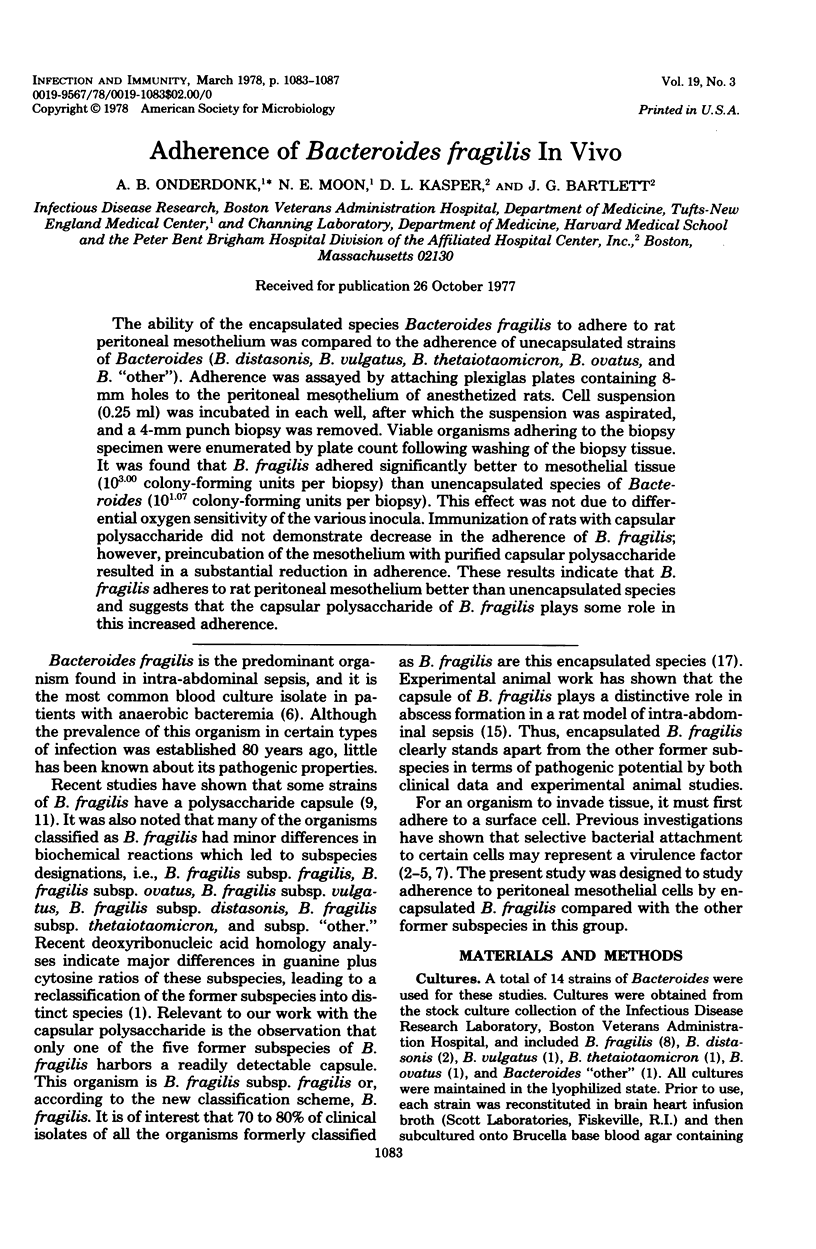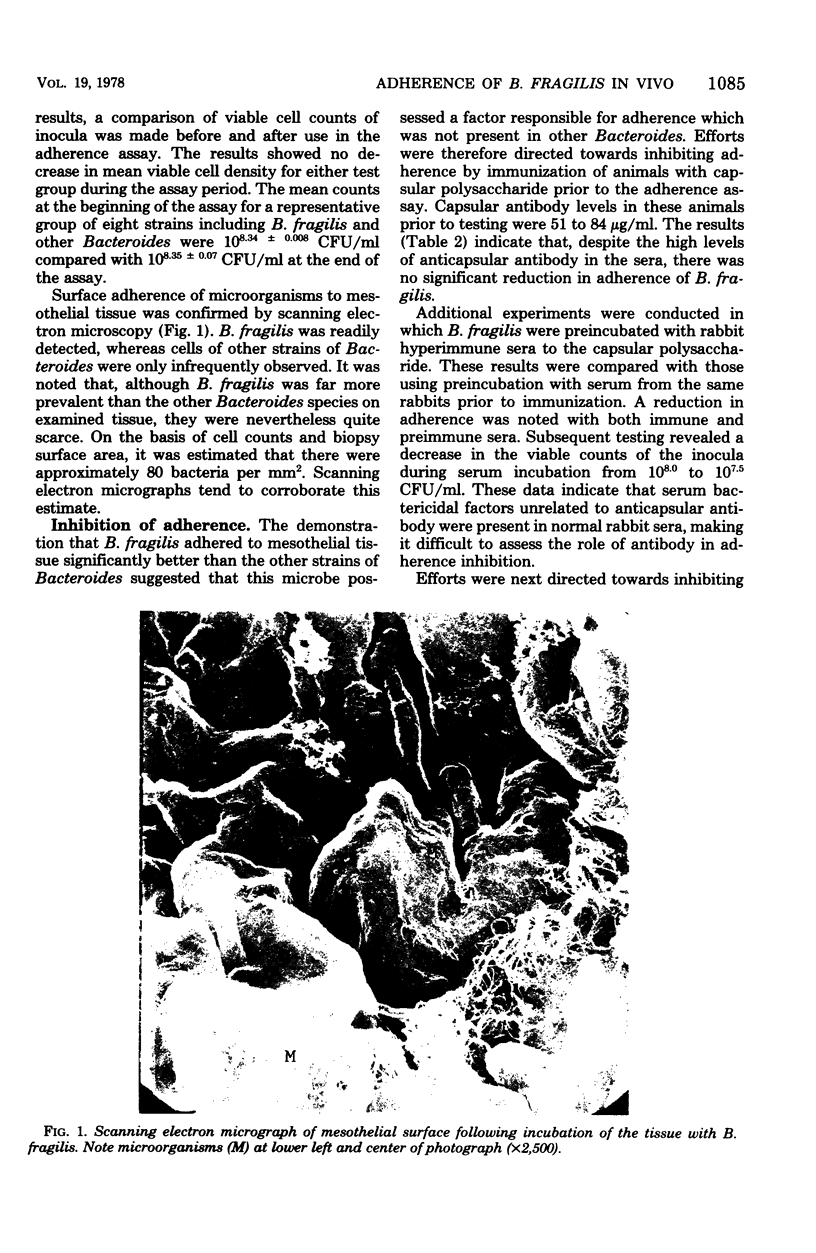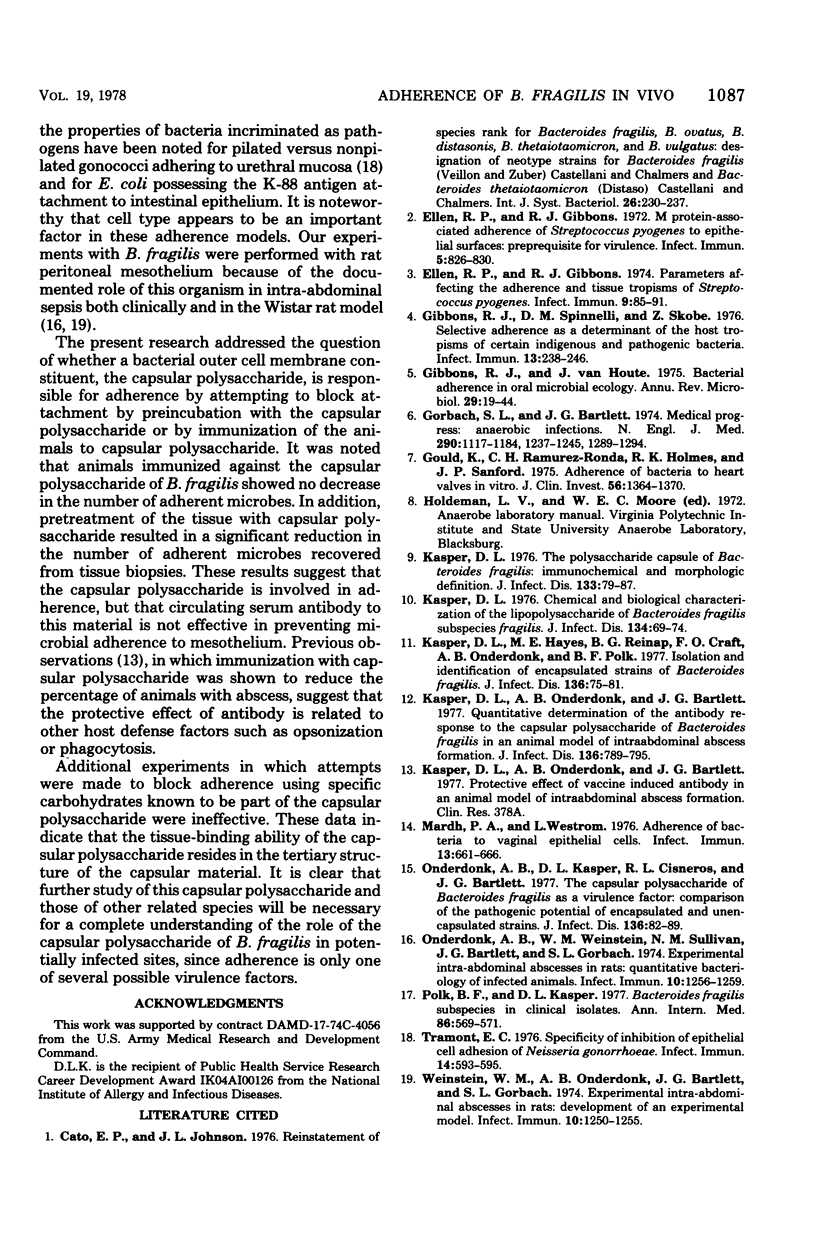Abstract
The ability of the encapsulated species Bacteroides fragilis to adhere to rat peritoneal mesothelium was compared to the adherence of unecapsulated strains of Bacteroides (B. distasonis, B. vulgatus, B. thetaiotaomicron, B. ovatus, and B. "other"). Adherence was assayed by attaching plexiglas plates containing 8-mm holes to the peritoneal mesothelium of anesthetized rats. Cell suspension (0.25 ml) was incubated in each well, after which the suspension was aspirated, and a 4-mm punch biopsy was removed. Viable organisms adhering to the biopsy specimen were enumerated by plate count following washing of the biopsy tissue. It was found that B. fragilis adhered significantly better to mesothelial tissue (10(3.00) colony-forming units per biopsy) than unencapsulated species of Bacteroides (10(1.07) colony-forming units per biopsy). This effect was not due to differential oxygen sensitivity of the various inocula. Immunization of rats with capsular polysaccharide did not demonstrate decrease in the adherence of B. fragilis; however, preincubation of the mesothelium with purified capsular polysaccharide resulted in a substantial reduction in adherence. These results indicate that B. fragilis adheres to rat peritoneal mesothelium better than unencapsulated species and suggests that the capsular polysaccharide of B. fragilis plays some role in this increased adherence.
Full text
PDF




Images in this article
Selected References
These references are in PubMed. This may not be the complete list of references from this article.
- Ellen R. P., Gibbons R. J. M protein-associated adherence of Streptococcus pyogenes to epithelial surfaces: prerequisite for virulence. Infect Immun. 1972 May;5(5):826–830. doi: 10.1128/iai.5.5.826-830.1972. [DOI] [PMC free article] [PubMed] [Google Scholar]
- Ellen R. P., Gibbons R. J. Parameters affecting the adherence and tissue tropisms of Streptococcus pyogenes. Infect Immun. 1974 Jan;9(1):85–91. doi: 10.1128/iai.9.1.85-91.1974. [DOI] [PMC free article] [PubMed] [Google Scholar]
- Gibbons R. J., Houte J. V. Bacterial adherence in oral microbial ecology. Annu Rev Microbiol. 1975;29:19–44. doi: 10.1146/annurev.mi.29.100175.000315. [DOI] [PubMed] [Google Scholar]
- Gibbons R. J., Spinell D. M., Skobe Z. Selective adherence as a determinant of the host tropisms of certain indigenous and pathogenic bacteria. Infect Immun. 1976 Jan;13(1):238–246. doi: 10.1128/iai.13.1.238-246.1976. [DOI] [PMC free article] [PubMed] [Google Scholar]
- Gorbach S. L., Bartlett J. G. Anaerobic infections (third of three parts). N Engl J Med. 1974 Jun 6;290(23):1289–1294. doi: 10.1056/NEJM197406062902305. [DOI] [PubMed] [Google Scholar]
- Gould K., Ramirez-Ronda C. H., Holmes R. K., Sanford J. P. Adherence of bacteria to heart valves in vitro. J Clin Invest. 1975 Dec;56(6):1364–1370. doi: 10.1172/JCI108216. [DOI] [PMC free article] [PubMed] [Google Scholar]
- Kasper D. L., Hayes M. E., Reinap B. G., Craft F. O., Onderdonk A. B., Polk B. F. Isolation and identification of encapsulated strains of Bacteroides fragilis. J Infect Dis. 1977 Jul;136(1):75–81. doi: 10.1093/infdis/136.1.75. [DOI] [PubMed] [Google Scholar]
- Kasper D. L., Onderdonk A. B., Bartlett J. G. Quantitative determination of the antibody response to the capsular polysaccharide of Bacteroides fragilis in an animal model of intraabdominal abscess formation. J Infect Dis. 1977 Dec;136(6):789–795. doi: 10.1093/infdis/136.6.789. [DOI] [PubMed] [Google Scholar]
- Kasper D. L. The polysaccharide capsule of Bacteroides fragilis subspecies fragilis: immunochemical and morphologic definition. J Infect Dis. 1976 Jan;133(1):79–87. doi: 10.1093/infdis/133.1.79. [DOI] [PubMed] [Google Scholar]
- Mårdh P. A., Westtöm L. Adherence of bacterial to vaginal epithelial cells. Infect Immun. 1976 Mar;13(3):661–666. doi: 10.1128/iai.13.3.661-666.1976. [DOI] [PMC free article] [PubMed] [Google Scholar]
- Onderdonk A. B., Kasper D. L., Cisneros R. L., Bartlett J. G. The capsular polysaccharide of Bacteroides fragilis as a virulence factor: comparison of the pathogenic potential of encapsulated and unencapsulated strains. J Infect Dis. 1977 Jul;136(1):82–89. doi: 10.1093/infdis/136.1.82. [DOI] [PubMed] [Google Scholar]
- Onderdonk A. B., Weinstein W. M., Sullivan N. M., Bartlett J. G., Gorbach S. L. Experimental intra-abdominal abscesses in rats: quantitative bacteriology of infected animals. Infect Immun. 1974 Dec;10(6):1256–1259. doi: 10.1128/iai.10.6.1256-1259.1974. [DOI] [PMC free article] [PubMed] [Google Scholar]
- Polk B. F., Kasper D. L. Bacteroides fragilis subspecies in clinical isolates. Ann Intern Med. 1977 May;86(5):569–571. doi: 10.7326/0003-4819-86-5-569. [DOI] [PubMed] [Google Scholar]
- Tramont E. C. Specificity of inhibition of epithelial cell adhesion of Neisseria gonorrhoeae. Infect Immun. 1976 Aug;14(2):593–595. doi: 10.1128/iai.14.2.593-595.1976. [DOI] [PMC free article] [PubMed] [Google Scholar]
- Weinstein W. M., Onderdonk A. B., Bartlett J. G., Gorbach S. L. Experimental intra-abdominal abscesses in rats: development of an experimental model. Infect Immun. 1974 Dec;10(6):1250–1255. doi: 10.1128/iai.10.6.1250-1255.1974. [DOI] [PMC free article] [PubMed] [Google Scholar]




